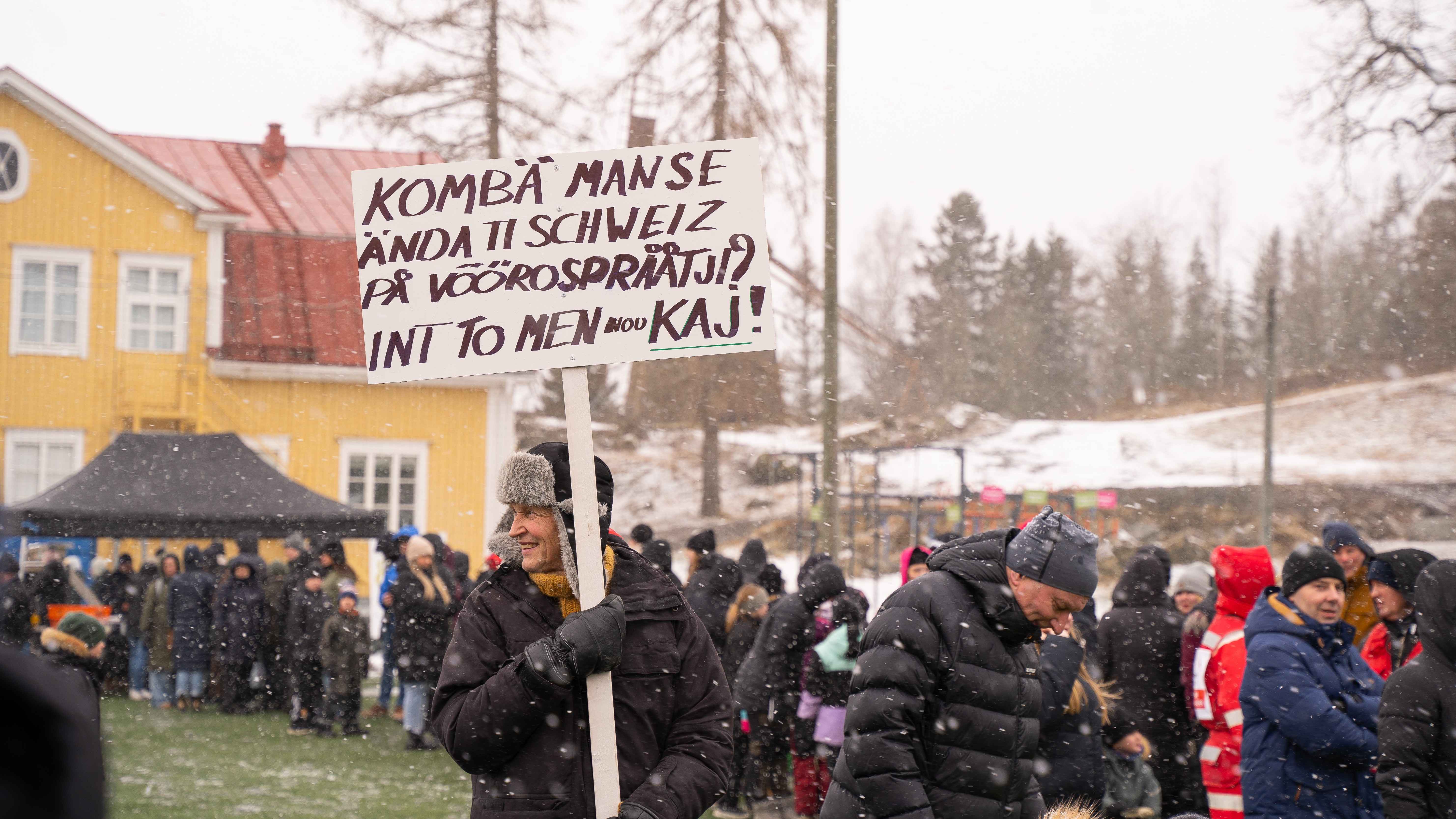Finland's April elections a test for local power structure
Finland holds municipal elections in April. At the same time, there are council elections in 21 so-called wellbeing services counties. After the healthcare reform, they will be responsible for social and healthcare services. But interest in running as a candidate and in voting seems to be falling. Perhaps due to a worsening economy and reduced municipal powers. Or because elections have become too frequent.
Simultaneous regional and municipal elections is a model that used to exist in Denmark and Norway. Sweden holds three elections at once, as voters also vote in the parliamentary elections.
Yet Finland is not going that far. Instead, people have to vote more frequently, including in presidential elections every six years. In the Finnish system, people vote for a named candidate in all types of elections.
Finnish local government expert Siv Sandberg is often asked to provide background and explain new trends. Right now, she is celebrating the winners of the Swedish Eurovision Song Contest finals, the comedy group Kaj, who are turning their home municipality of Vörå in Finland on its head. 
Axel Åhman, Kevin Holmström and Jakob Norrgård performed at a party in their old home municipality of Vörå just one week after being crowned the Swedish entry to the Eurovision Song Contest. Photo: Vörå municipality
Culture used to be a fairly “quiet” policy area, rarely sharing opinions. That is why we meet her at the Helsinki Central Library Ode, one of Finland’s most visible and most expensive libraries.
Finland deviates from the Nordic model – but the core values remain
So, how important is the municipality as a unit in Finland compared to the rest of the Nordics?
“Finland has taken a step away from the traditional Nordic municipality with a strong service production. Once, we talked about the Nordic welfare municipality, but now not even elderly care is part of municipal services in Finland.”
That is a major deviation from the model that has grown in the Nordic region since the 1500s, points out Siv Sandberg.
Yet the core values remain, along with the view of the municipalities’ institutional role and municipal democracy. The municipalities are still responsible for education, land planning and culture, just like in the other Nordic countries.
Municipalities’ power and responsibilities have been reduced, but most have maintained the size of their municipal councils. The number of council seats follows the population size. The minimum is 17 seats, but the smallest municipalities can go as low as 13 seats.
Expensive fight for votes
There is a lack of candidates in the smaller municipalities, which means all candidates get a seat. Larger places see an increased interest in taking part in decision-making, however.
In Helsinki, nearly 1,000 candidates are fighting for the city’s 85 city council seats. It can be difficult for voters to get to know and decide between so many candidates. This gives MPs a strong chance of being elected, for instance.
Celebrity factor and polarisation a threat to municipal democracy?
Critics have said the Finnish electoral system gives too much advantage to the celebrity factor, as voters pick a candidate – not the party. This means that factors other than competence and political views can influence the outcome, including a candidate's ability to invest money in their campaign.

Finnish local government expert Siv Sandberg at the Ode Library. She is also a lecturer at Åbo Akademi University.
Another factor is how the polarisation of Finnish society impacts voter turnout. Voting activity has increased in municipal elections. But in Eastern and Northern Finland, turnout is below 50 per cent, which Siv Sandberg calls a peripheral issue.
The polarisation might have led to social indifference in the least populated regions, and to the opposite in cities in Southern Finland.
Sustainable municipal democracy
Several political parties have failed to put up the maximum number of candidates in the Finnish elections on 13 April. It is particularly difficult to get younger candidates to engage. Debates have become tougher and politicians’ role less attractive.
In certain places, the majority of the candidates are retired people, points out Siv Sandberg.
“That means that many have a lot of time to spend on their mission, but it highlights a dilemma with our system. The job as a councillor demands personal sacrifice, and people who have jobs don’t have the time.
Sandberg refers to the debate in Sweden about how sustainable and effective the municipal democracy really is, whether there are enough local politicians – and the issues become increasingly complex.
Competence at the municipal office
The high level of competence and expertise at municipal offices across the Nordics is a strength, underlines Siv Sandberg.
“The municipalities are pretty good at adapting to new realities and doing the best with what they have. We might be blind to this, but we have a very well-educated and professional management in the municipalities.”

Money has been spent on culture in Helsinki. The Ode Library’s book lending and reading rooms are situated in the “Book heaven” on the third floor. This is also where you find the citizens’ balcony with a great view. There are meeting rooms, workshops, studios and games rooms.
It is a good thing, because municipalities are facing significant financial problems with the downward spiral of a shrinking population.
The age demographics in Finland could lead to reduced state subsidies as there are fewer children in schools, says Siv Sandberg. Not having enough taxpayers still represents a dilemma on the expenditure side.
Yet the municipalities nearly always complain about not having enough money. There have been many warnings about falling growth and a declining population. Finland might be ahead of the rest of the Nordics here.
Siv Sandberg talks about a somewhat oversized infrastructure, for instance in the school sector. But it could also be that all possible school mergers have already happened.
What do political parties want?
The ideological differences in municipal politics centre around the relationship between the state and the municipality as well as issues related to land use planning.
The National Coalition Party is the largest political party both locally in Helsinki and nationally, advocating for the conditions of local businesses.
The Greens are also a distinct urban party, focusing on traffic issues and urbanisation. The Finns Party has never been a strong municipal party and has gathered fewer candidates in this election.
They made progress in the latest local elections at the expense of the Centre party, which failed to break through in the cities while being part of the government coalition. Now, the tables have turned.
The centre-right parties are now in opposition in parliament and have seen a rise in opinion polls. The Social Democrats and the Left Alliance are more in favour of keeping things under local municipal control, in contrast to the National Coalition Party, which wants to open up the market, explains Siv Sandberg.
The left-wing parties may be seen as promoting policies that secure resources for municipalities and welfare, making the municipalities secure workplaces for many employees.
Parties in control, soon also in schools
Education remains a major political issue ahead of the municipal elections. Siv Sandberg observes that some politicians are keen to intervene.
There are talks of more detentions and restrictions on mobile phone use, and the Finns Party speaks vaguely about putting an end to "perversities" and about too much tofu in school meals.
At the municipal level, school boards already exist, so politicians are not completely outside the process even now. In Finland, there have not been many independent single-issue movements, unlike in Sweden, where a "healthcare party" emerged.
Large cuts in healthcare and maternity wards or controversial industry expansion decisions could have drawn criticism, but this has only occurred in isolated cases, says Siv Sandberg.
Employment is now a municipal responsibility
Healthcare has been transferred to the wellbeing services counties, and municipalities have been handed responsibility for employment services instead. The state's labour and business services at the so-called TE centres were transferred to municipalities at the turn of the year, and the staff followed.

The city of Vanda took over employment services in January. Director of Employment and Integration Susanna Taipale-Vuorinen unfurls a banner about the objective: to provide vitality and employment services that are among the best in Finland.
The main idea is to bring services closer to the clients in a service model where local characteristics are allowed and encouraged to shine. It also creates a collaboration with the voluntary sector and private employment agencies for better labour force matching and regional mobility.
According to the Ministry of Employment and the Economy, the reform has had a good start and employment could be a theme for the municipal elections since there are still things to do.
The reform was introduced by Sanna Marin’s government, and the centre-right coalition has taken it on.
Siv Sandberg says it is too early to assess whether it has been a success.
“This was a significant and principled reform that really just passed without much debate, perhaps because everyone was tired of reforms,” says Siv Sandberg.
Unemployment has increased since then, so there is a risk that the municipalities feel they have been tricked into taking over the state’s responsibilities without being given the proper tools or money to solve the crisis.
“Bara bada bastu”
There have also been examples of new ways of working in the municipalities. Siv Sandberg mentions Vörå municipality as an example.
Just a few days after the comedy group Kaj won the Swedish Eurovision finals, their Finnish home municipality welcomed the members home with a huge party with 5,000 guests. 
Many of Kaj’s songs are performed in a thick Vörå dialect, which is popular in their home municipality. Locals also hope for a good result in the international Eurovision finals in Basel in May. Photo: Vörå municipality
“Bara bada bastu” (Just Take a Sauna) has become the municipality’s signature tune, and the municipality can benefit from “its” contribution – first in Sweden and then in the Eurovision finals in Basel in May.
The idea, of course, is to increase the sense of community and pride among the residents about their identity and dialect.
This is the kind of thing that can help a municipality’s image and attract new residents, tourists and businesses to the little municipality in Ostrobothnia, population 6,000.
- The local government expert
-
The Finnish municipal researcher Siv Sandberg at the Central Library’s third floor, from where you can spot Medborgartorget (Citizen’s Square) – a popular space for demonstrations – and behind it, Parliament House. National politics play a key role, despite Finnish municipalities’ level of autonomy.
- Municipal Finland
-
- There are 307 municipalities in Finland, 108 of which use the designation “city”.
- The most populous and densely populated municipality is the capital, Helsinki, with around 664,028 inhabitants.
- The smallest municipality on mainland Finland is Luhanka with 692 residents, and the smallest city is Kaskinen with 1,256 residents.
- The smallest municipality in the Åland archipelago is Sottunga, with around 100 residents. Åland is a special case in Finland with 15 small municipalities housing just over 30,000 people. Nearly half of them live in Mariehamn.
- Finland’s biggest municipality by area is Inari in the northernmost Lapland/Sápmi, with an area measuring around 17,334 km².
- The smallest municipality is Kauniainen near Helsinki, measuring around 6 km².
 Follow us on Facebook
Follow us on Facebook
